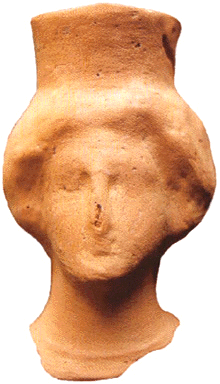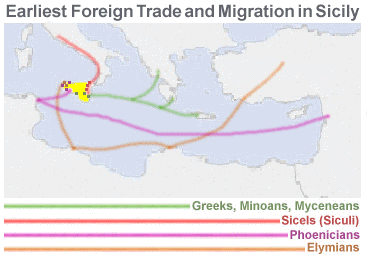...Best of Sicily presents... Best of Sicily Magazine. ... Dedicated to Sicilian art, culture, history, people, places and all things Sicilian. |
by Vincenzo Salerno | |||||
Magazine Index Best of Sicily Arts & Culture Fashion Food & Wine History & Society About Us Travel Faqs Contact Map of Sicily
|
The ancient Greeks sought to identify the Elymians with the inhabitants of Troy. While this theory is unsupported by known evidence, it does reflect at least a grain of truth if we consider that the Elymians were probably descendants of an eastern Mediterranean society influenced by the Greeks, Phoenicians, Assyrians and other peoples. (Anatolia is sometimes mentioned.) This may partly explain their ready Hellenization after 600 BC, developing into a society virtually indistinguishable from that of Greek-founded cities such as nearby Selinus (Selinunte). The Greeks, however, tried to paint the Elymians as a kindred race for the sake of political propaganda justifying their occupation of western Sicily --and ousting the Phoenicians' residual society, the Carthaginians, from that region. After 500 BC, the Elymians frequently found themselves torn by loyalties to the Carthaginians or Greeks, or to a particular Greek faction. By While the Elymians, at least in their remote origins, were probably west Asian, the Sicels of eastern Sicily were probably Italic. Unlike the Sicels, the Elymians appear never to have sought independence from the Greeks who colonised their corner of Sicily, nor did they engage in open conflict with the Phoenicians who established coastal outposts at Motia, Palermo and other places. The most credible explanation for this is that the Elymians embraced the benefits of increased trade, and already bore much in common with these newer arrivals. Their language, like that of the Sicels (but unlike that of the Sicans), was Indo-European, offering the possibility for easy communication with the Phoenicians and Greeks. Known Elymian civilisation bears a few traces of contact with Minoan cultures, though the implications are inconclusive: One theory suggests that the Minoans may have shared some remote roots with the Elymians, and probably traded with them. Certain theories regarding the historically elusive Elymians have found their way into popular thought, yet remain unproven and, at best, circumstantial. We do not know whether the Elymians were the first to introduce the use of large horses in Sicily, and we do not know if they were the first Sicilians to use copper and bronze. In view of the facts as we know them, it may be more appropriate to attribute both developments to the Sicanians who were already here when the Elymians arrived, and had been influenced by other Mediterranean civilizations. Scholars identify Sicily's Bronze Age with the Sicanians, citing 2500 BC as a credible date. The date of the Elymians' arrival in Sicily is also debated. While 1100 BC is generally agreed by scholars to be the most recent likely period of their arrival, the Elymians may have been present in northwestern Sicily centuries earlier. (It is sometimes difficult to distinguish early Elymian archeology from that of Sicanian civilization; the Sicanians appear to descend from the Neolithic peoples who once inhabited all of Sicily, including the areas later occupied by the Elymians and Sicels.) Another mystery is their language. We know more of Sicel than we do of either Elymian or the more linguistically isolated Sicanian. Little of the written Elymian language has been discovered in archeological elements dated to their civilization as it existed before the arrival of the Phoenicians and Greeks, and what has been found (using Greek characters with a few Phoenician ones in tablets found at Entella and inscriptions at Segesta) has not been satisfactorily translated. Indeed, it is their early assimilation with both societies, and particularly that of the Greeks, that often makes it difficult to clearly identify the Elymian culture at all. In other words, in archeological studies it is not always easy to distinguish early Elymian settlements from later Elymo-Greek ones (such as Hellenic Segesta) because the Elymians so rapidly adapted Greek art and architecture as their own. It appears that the Elymians lived in just a few localities before 700 BC, but the hypothetical discovery of even a small --but exclusively Elymian-- settlement could shed new light on our knowledge of their civilization. (Even in Sicily, such archeological discoveries are not unknown.) The "Elymo-Greek" culture emerged by 500 BC, flourishing in places such as Segesta and Erice, though in the latter locality Phoenician and Carthaginian traces are particularly evident. Ethnologically, this was an advanced society with a particular affinity to Hellenic ones. As far as we know (genetic studies could alter the theory), the Segestans living in the third century BC were essentially Elymian descendants, with perhaps some Greek ancestry based on the influx of some Greeks from eastern Sicily. Relations with Selinus (founded by settlers from Megara Hyblea descended from the Greek-born Megarians) were complicated, though apparently based on political considerations rather than ethnic ones. The numerous Greek communities in Italy were founded by settlers originating in various parts of Greece, and this partly explains their alliances and differences, but there is nothing to suggest a "racial" discrimination against the Elymo-Greeks. Except perhaps in Eryx (Erice), the Carthaginian cultural influence on the Elymo-Greeks seems to have been minimal, or perhaps minimized, over time as the Carthaginians were gradually reduced to a minor role in the central Mediterranean. The culture of the Phoenicians and their residual society in northern Africa (the Carthaginians) certainly influenced the Elymi, especially through trade, and their coastal outposts were not far away. The Elymians remain an interesting, though perhaps arcane, footnote to central Mediterranean history. We do not know how many Elymians were alive when the Greeks arrived, but theirs was clearly the smallest population of the three native societies of Sicily, and this doubtless contributed to the speed of their assimilation and amalgamation. Their religious cults were similar to those of the Greeks. The worship of the Greeks' Aphrodite probably shared its affinity with an earlier Elymian cult, also associated with the Phoenicians' goddess Astarte. They appear to have venerated the dog, probably as a symbol of some particular trait or physical condition, and the name of Eryx (Erice) is based on that of a mythical Elymian king and hero. We do not know with certainty what kind of government prevailed in Elymian cities and towns, but their society appears to have been a pacific one prior to the arrival of the Carthaginians and Greeks, whose complex Mediterranean politics brought the Elymians (and their Elymo-Greek descendants) into several particularly bloody wars. Theories about the Elymians abound but by 700 BC, when the Phoenicians and Greeks arrived, there was little to distinguish their bronze-age society from those of the other Sicilians. Except for observations based on discovery of a few artefacts, the archeological record offers little conclusive information about this most ancient civilization which shaped the earliest culture of northwestern Sicily. Genetic Research: In general, studies of population genetics in Sicily tend to confirm, rather than refute, what we already presume to know about the various Sicilian peoples based on available historical, archeological and ethnological information. Here is a brief summary of an early genetic study involving potential identification of Sicily's three "native" peoples correlative to genetic factors in the current population: Autosomal Microsatellite and mtDNA Genetic Analysis in Sicily DNA samples from 465 blood donors living
in seven (7) towns of Sicily have been collected according
to well defined criteria, and their genetic heterogeneity A more reliable association of these diachronic genetic strata to different historical populations (e.g. Sicani, Elymians, Sicels), if possible, must be postponed to the analysis of more samples and hopefully more informative uniparental DNA markers such as the recently available DHPLC-SNP polymorphisms of the Y chromosome. V. Romano, F. Calì, A. Ragalmuto, R. P. D'Anna, A. Flugy, G. De Leo, O. Giambalvo, A. Lisa, O. Fiorani, C. Di Gaetano, A. Salerno, R. Tamouza, D. Charron, G. Zei, G. Matullo and A. Piazza - - - Annals of Human Genetics, January 2003 (Volume 67, Number 1, Page 42). About the Author: Palermo native Vincenzo Salerno has written biographies of several famous Sicilians, including Frederick II and Giuseppe di Lampedusa. | ||||
Top of Page |
 As a result of their rapid assimilation with the Greeks, the Elymians remain the most mysterious of Sicily's three ancient "indigenous" peoples (Sicanians, Sicels, Elymians). By 1100 BC (BCE), the Elymians (or Elymi, Elimi or Elami, from the Greek Elymoi) had established several cities in northwestern Sicily, apparently displacing the
As a result of their rapid assimilation with the Greeks, the Elymians remain the most mysterious of Sicily's three ancient "indigenous" peoples (Sicanians, Sicels, Elymians). By 1100 BC (BCE), the Elymians (or Elymi, Elimi or Elami, from the Greek Elymoi) had established several cities in northwestern Sicily, apparently displacing the  that time, however, the native Elymian culture was Hellenized to the extent that little of the old society remained. Nothing exemplifies this more than the imposing Greek temple of Segesta, built around 430 BC. Identifying typically "Elymian"
that time, however, the native Elymian culture was Hellenized to the extent that little of the old society remained. Nothing exemplifies this more than the imposing Greek temple of Segesta, built around 430 BC. Identifying typically "Elymian"  tested on the
basis of 9 autosomal microsatellite and mitochondrial DNA polymorphisms
for a total of 85 microsatellite allele and 10 mtDNA haplogroup frequencies.
A preliminary account of the results shows that: a) the samples are genetically
heterogeneous; b) the first principal coordinates of the samples are correlated
more with their longitude than with their latitude, and this result is even
more remarkable when one outlier sample (Butera) is not considered; c) distances
among samples calculated from allele and haplogroup frequencies and from
the isonymy matrix are weakly correlated (r = 0.43, P = 0.06) but such correlation
disappears (r = 0.16) if the mtDNA haplogroups alone are taken into account;
d) mtDNA haplogroups and microsatellite distances suggest settlements of
people occurred at different times: divergence times inferred from microsatellite
data seem to describe a genetic composition of the town of Sciacca mainly
derived from settlements after the Roman conquest of Sicily (First Punic
War, 246 BC), while all other divergence times take root from the second
to the first millennium BC, and therefore seem to backdate to the pre-Hellenistic
period.
tested on the
basis of 9 autosomal microsatellite and mitochondrial DNA polymorphisms
for a total of 85 microsatellite allele and 10 mtDNA haplogroup frequencies.
A preliminary account of the results shows that: a) the samples are genetically
heterogeneous; b) the first principal coordinates of the samples are correlated
more with their longitude than with their latitude, and this result is even
more remarkable when one outlier sample (Butera) is not considered; c) distances
among samples calculated from allele and haplogroup frequencies and from
the isonymy matrix are weakly correlated (r = 0.43, P = 0.06) but such correlation
disappears (r = 0.16) if the mtDNA haplogroups alone are taken into account;
d) mtDNA haplogroups and microsatellite distances suggest settlements of
people occurred at different times: divergence times inferred from microsatellite
data seem to describe a genetic composition of the town of Sciacca mainly
derived from settlements after the Roman conquest of Sicily (First Punic
War, 246 BC), while all other divergence times take root from the second
to the first millennium BC, and therefore seem to backdate to the pre-Hellenistic
period.